The best ever with the most beautiful women ever in the very best time of history. They won’t come back. They have left us the memory of their exploits. They lived at 180 miles an hour and mocked life. Different but the same in being gentlemen. They knew women, they loved them, they made them happy. Above all, very important, they were having a wonderful time. Lives with no routine, what more could you want? The highest point of man’s existence reached countless times. On the world’s most beautiful scenes. They were young, handsome, charming and they had the touch with the ladies. There was a line to be with them. A time that doesn’t exist anymore. Some of them were unable or unwilling to accept the second part of their lives, too good the first one, you couldn’t. For them, more than the others, hard to get old.
Gigi Rizzi
You die better, perhaps, if you’ve loved Brigitte Bardot. From “Il Covo” to “Le Carillon” and to “El Pirata”, who judges him just a playboy doesn’t know his friendly and gentle nature. He has been given but always reciprocated.
A real gentleman, from a good family, smart and sincere. He was dripping purest charm of every pore, also in the voice. Straightforward, spontaneous, a lover of good company, with a great sense of humor and engaging energy. One of the most famous play-boy of the fabulous 60's & early 70's. He was lover and partner of the most beautiful women of his times, Brigitte Bardot, Veruska, Dominque Sanda, Fiona Lewis, Isa Stoppi and some more.

Gigi Rizzi was a great lover of life and women. The third of four children, he’d been born in Piacenza in 1944 during an Allied air raid; his father owned a brick-making business. The young Gigi wasted no time in rebelling against perbenismo, the bourgeois code of respectability: his first conquest, at age of 14, was the family’s governess.
Nervi, a district of Genoa, was his home for a long time, but by the late sixties, he and his confrères were making fairly choppy waves on the Côte d’Azur in general, and the newly fashionable Saint-Tropez in particular.

Brigitte Bardot with Gigi Rizzi, here barefoot towards Byblos in Saint Tropez in 1968.
Rizzi was the leader of a group of Italian gigolos who lived out a kind of Fellini fantasia and makes their way into Byblos, the most popular disco in the French city. They move toward their reserved table wearing open shirts that showcase the pendants skimming their chests, with a caviar tart in one hand and a glass of champagne in the other.
Gigi and his friends acquired the nickname “Les Italiens”; invincible in their female conquests, they used to pamper their women with the latest fashions, invitations to exclusive parties, and dinners in elegant restaurants. Rizzi’s crew included Beppe Piroddi, who was then squiring Odile Redon, the last love of echt-playboy Porfirio Rubirosa; Franco Rapetti, known as The Prince; and Rodolfo Parisi.

“They were the most good-looking, suntanned Italian playboys. They ruled the scene on Capri,” said the socialite Pilar Crespi Robert in a Vanity Fair interview. “They were straight. They always had beautiful American girlfriends. Very glamorous. Leather pants, open shirts with chains.”
Rizzi said: “We, Italian guys in Saint Tropez, had to fight against the multimillionaires to impress, to conquer. I didn’t own a Ferrari or a Rolls Royce or even a 100 feet yacht, all I had was my face, and that made the challenge even more exciting… When Gunter Sachs came, Brigitte’s ex-husband, playboy and billionaire, he landed from his helicopter dressed as Dracula, throwed tons of red roses, entered the port with his Acquarama (…). I danced flamenco on the table kicking glasses. Bare feet, jeans, hair in the wind and go. Fuck you. We were poisonous, unmistakable..”
It was a picaresque odyssey. He would later write: “I often went by train, and would make my way home as best I could when the money ran out.” In the summer of ’68 Rizzi’s charms were not lost on Brigitte Bardot… its valedictory round-up of 1968’s most notable people, the magazine Newsweek singled out the year’s headliners: Che Guevara, Christian Barnard and Gigi Rizzi.
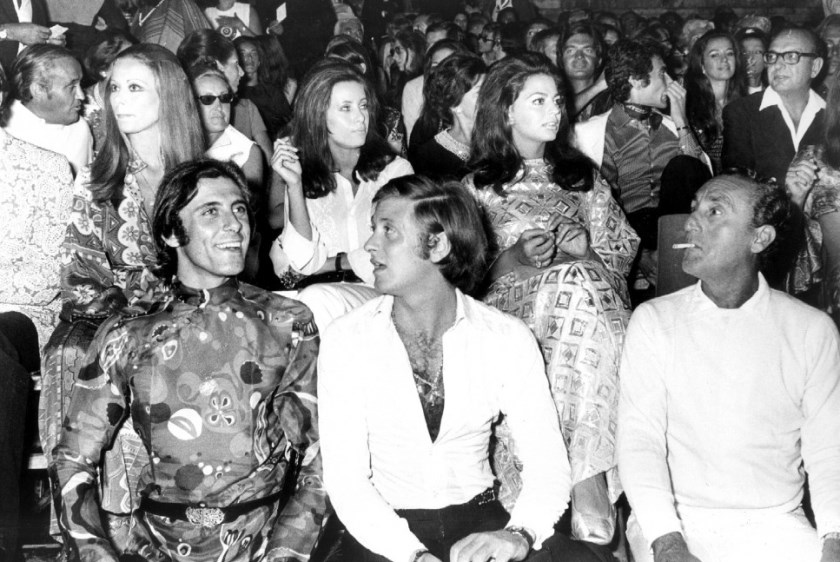
Rizzi had done something momentous and epoch-making. That summer he had become the most envied man on the planet as the playboy consort of the ultimate French bombshell, Brigitte Bardot. Photos of the time show Bardot and Rizzi cutting a swathe through various palm-fringed rivieras — Saint-Tropez, of course, where Bardot held court in her villa, La Madrague, but also Capri, where she had shot Contempt with Jean-Luc Godard. She tends to be wearing floppy sun hats and cotton vests or micro-dresses; he’s in shirts that are slashed to the navel and low-slung cords or velvet trousers, accessorised with the crispiest of tans, a cat-who-got-the-cream grin, and a kind of lithe-if-not-exotic athleticism — Alain Delon with floppier hair, or Johan Cruyff with a more saturnine edge. Occasionally they sport matching piratical bandanas.
“This was a crazy moment,” said the designer Valentino, who bought the Villa Cercola, one of Capri’s oldest villas, just as the island’s reputation for libertinism became turbo-charged. “All the fashion people, all the models, all the movie stars, it was a sort of dolce vita.” If Rizzi had a romantic notion of himself as some kind of licentious counter-revolutionary — “while French students burned flags and occupied universities in ’68, we were engaged in our own battle against conformity,” he later wrote in a memoir, “Io, BB, e l’altro ’68” (Me, BB, and the other ‘68) — it was true that the champagne-dreams-caviar-kisses lifestyle wasn’t his by birthright.
Gigi Rizzi gave a glimmer of light during historically turbulent years by opening the first Italian disco, the “Number One.” Quickly achieving success, the little gem of “made in Milan movida,” boasted frills, vices, and barefoot dancing on tables. The most talked about disco also debuted in Rome, near via Veneto. Unfortunately, the oasis of delights had a short-life span: after only three years a so-called “Number One Scandal” exploded because of cocaine found in the bathrooms and the club was forced to shut down.

“The ‘Italian playboy’: that’s what his friends, the press, and women used to call him. They were aware of the irresistible charm of the man who became a fashion legend and an icon of the Italian good life. The contrast between the historical and social context of the 1960s and his apathy to politics made his persona even more interesting. A man ― one of the few ― who in the revolutionary mood of those years, found a breeding ground to express his exuberance, his openness, his non-conventionality, and his unconditional love for pleasure. His unaware ― naive at times ― appearance and his approach of living life without expecting anything in return, helped to increase his charm even more.
However, the chief reason Gigi Rizzi was identified for his entire life as the “Italian playboy” was due to his fling with the woman icon of that period, still famous today for her extraordinary beauty. She is Brigitte Bardot. Capricious, fascinating, sensual: the actress was the erotic dream of all men and she held this role for the next 20 years. Despite her reputation of femme fatale it seems that she herself made the first move: during a party, she passed a note to Gigi Rizzi inviting him to go water-skiing the next day at her famous villa. Why him? Maybe because of his beautiful face, his funny spirit, or maybe, thanks to his interesting life.
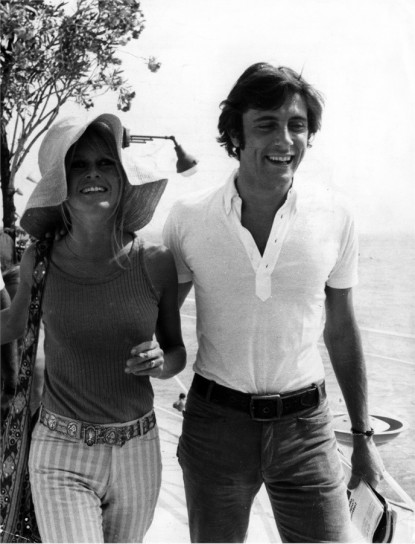
“Fish soup and wine, my first date with Brigitte.” Reading the news in magazines, it almost felt like Italy had struck a blow against its French neighbours, conquering their “queen” with a triumph equal to a victory at a world football championship. This is why the fairer sex is very important for Italian men, as the reputation of “latin lover” or “great lover” is the daily bread for their ego. The flirtation between the two was seen as national revenge, which was the dream of a generation.
It was 1968, and everyone was in love. Gigi needed freedom, one that his father didn’t teach him. He was a rebel in a sense. And even if the most famous “liaison” of that period finished when the French diva’s whim was satisfied, three months later the thought of Brigitte, her beauty, and their quality time together had never left the actor’s mind. In fact, after several years, on the occasion of the Bardot’s 70th birthday, he wrote her a letter that was published in every major newspaper:
“Dear Brigitte, I am writing you from another world, from another life, from another city. I look for a flower for those eyes that once made frrrr and today are moved by seals and whales. I look back and I see Saint-Tropez, the infernal bedlam of Esquinade, endless nights between the Escale and the Papagayo, and a night when you were there to applaud Les Italiens. Happy birthday.

I know where you live now because I passed by a long time ago, when the joy of living was with us, kids with a dream. It was ’68, and I was dancing barefoot on tables, always out to win, never worrying about tomorrow. I was 24, and on French soil I felt like a musketeer, drinking Cointreau with Johnny Halliday and playing football with Gilbert Bécaud in the afternoons on Place Delice, then I kidnapped some female friend on the beach of Pampelonne and I waited for the sunset like a child.
I was engaged to the night when we first met. You seemed a Martian, an extraterrestrial of stratospheric beauty. But you weren’t that despotic character described in the newspapers. You were fragile, melancholic, intelligent, sensitive, jealous of intimacy: you became furious if someone violated it. Like the photographers, who were using flash like a bazooka.
There are myths built on the cardboard: no lies, you were real. That’s why you were so liked. Those closest to you felt like the most important men in the world. You wanted to breath even her air. I feel even now the drift of that summer together, and sometimes I wonder what will I be without that media bombing which thirty-six years ago brought me, with your picture, on the cover of Newsweek.

Perhaps I would have been a nobody and I’d have had less photos in the paper, but my life would have been the same, as well as the affective capital that I feel around me. Family, children, friends are the most important conquest. I love animals too and I appreciate your environmentalist battles.
But I have never shared with you what you thought then: animals don’t cheat, men do it. I, in spite of everything, believe in humans. I like your way of contradicting the platitudes. It’s a test of courage, never hide to time. Hang on, Brigitte, but try not to see only enemies around you. If you go back in the other world, the one where I live happy and in love, you’ll still find a friend. A bientôt.”
A beautiful and deep letter that is not just about caviar and champagne, but about emotion ― real feelings ― that he didn’t forget even after almost 40 years. The same emotions that can live in the mind and memories of such a man ― Gigi ― who has always lived his life fully with no barriers.

Sin: it is a frequent word in Rizzi’s dictionary, so frequent that he decided to dedicate a TV program to it that was full of scandal and suspense. (Nothing new for the actor). He considered himself a real sinner always tempted to discover life in all its excess: lust, vices, drugs, and even mistakes. In the triangle of Milan, Portofino, and Saint-Tropez, he intertwined romances, parties, dancing on tables, and poker. He actually stated he had loaned $100,000 dollars to Ted Kennedy who had never paid him back.
As far as his style, besides his uniform of open shirts, Gigi Rizzi loved socks with relief stitches along the lines of Marlene Dietrich. On a woman, he went crazy for fishnet stockings, garters, and lace panties. All these clothes at the time were considered retro, but according to him were synonymous with sensuality.

However, in the mid-1970’s, to demonstrate that his love for life was not only just parties and luxury, the businessman decided to move to Argentina, where he bought a farm. But, after many years among pastures and cattle, in 2004 he returned to Italy. There, he decided to share passion, affection, and tenderness for the woman who had made him really famous, as well as happy: Brigitte Bardot. Gigi Rizzi left us in his beloved Saint Tropez, because of a quick illness, at the age of 69. The last Italian playboy worthy to deserve this name.
“I was 24 years old and had Brigitte Bardot,” he wrote. It is again and again becoming apparent to us how much the world wouldn’t want to change. How it was capable to deceive itself. Gigi said: “I remember headlines and hallucinated eyes of friends in those endless nights (…) the world was watching us a little envious, maybe indignant.”
Gunter Sachs
Gunter Sachs was dropping roses from his helicopter – that is how he got Bardot. Rich, handsome and good family background. He committed suicide because life is not a long-term game. But until he played Gunter enjoyed it like no one. Because Brigitte Bardot is the most beautiful woman ever, the ‘60s were the best times ever, Saint Tropez was magic.
 |
 |
Why keeping on playing if you cannot win? In addition to Bardot he had among other Soraya, and his beautiful third wife Swedish former model, married very young when she was only 26. You could have just said that there was Gunter Sachs on the phone and any woman would have been available. He had massive financial resources and he used them to win easily but he didn’t win due to the money only, he had charm and was really funny.
 |
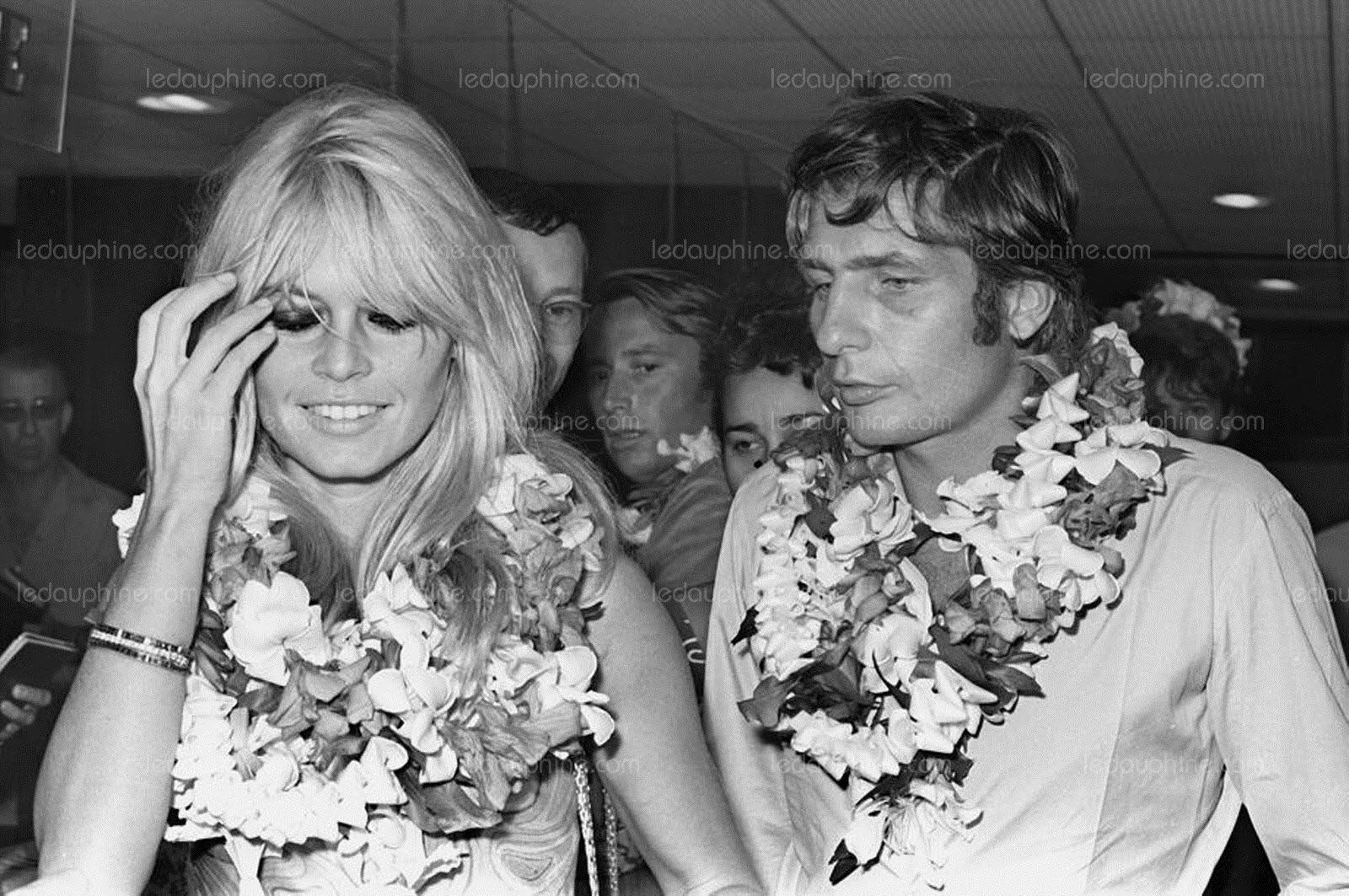 |
He was living life on his own terms, as if it had to end tomorrow. He loved sports and arts. In short, complete in every way. During the period when he lived in France he owned a 1961 Ferrari 250 GT SWB California Spider, car subsequently sold at auction for 16,8 million dollars.
 |
 |
Fritz Gunter Sachs (14 November 1932 – 7 May 2011) was a German photographer, author, industrialist, and latterly head of an institute that researched claims of astrology. As a young man he became a sportsman, then gained international fame as a documentary film-maker, documentary photographer, and third husband of Brigitte Bardot. Sachs was born in southern Germany. His mother was Eleanor, the daughter of Wilhelm von Opel, co-founder of the automaker Opel; his father was Willy Sachs, sole owner of Fichtel & Sachs, a leading manufacturer of ball bearings and one of Germany's biggest automobile suppliers.
 |
 |
Willy was friendly with Hermann Göring and Heinrich Himmler and arrested by the American military after the war but finally declared a follower and released. Gunter Sachs commented on his father's past in several publications. Willy committed suicide in 1958 by shooting himself. Sachs' brother, Ernst Wilhelm, died in an avalanche in 1977. Sachs studied maths and economics.
 |
 |
 |
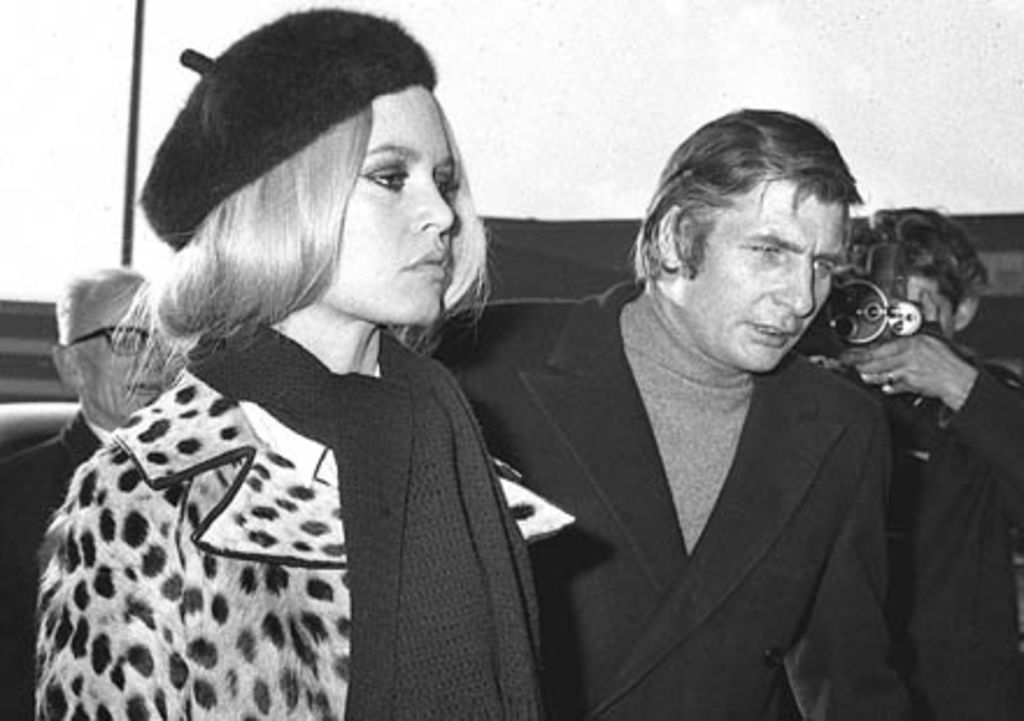 |
A playboy in his early years, Sachs was romantically linked to the former Iranian empress Soraya Esfandiary. He married three times. His first wife, Anne-Marie Faure, died in 1958 during surgery. He courted his second wife, Brigitte Bardot, by flying over her villa on the French Riviera in a helicopter and dropping hundreds of roses. The couple were married on 14 July 1966 in Las Vegas; they divorced in 1969. His final marriage was to Swedish former model, Mirja Larsson and lasted from 1969 until his death.
 |
 |
 |
He had a son Rolf Sachs (born 1955), with his first wife, and a further two sons (Christian Gunnar and Claus Alexander) with his third wife. In addition to his German nationality, Sachs received Swiss citizenship in 1976. From 1969 until his death, Sachs was the chairman of the St. Moritz Bobsleigh Club. Turn 13 of the St. Moritz-Celerina Olympic Bobrun is named in his honour.

 |
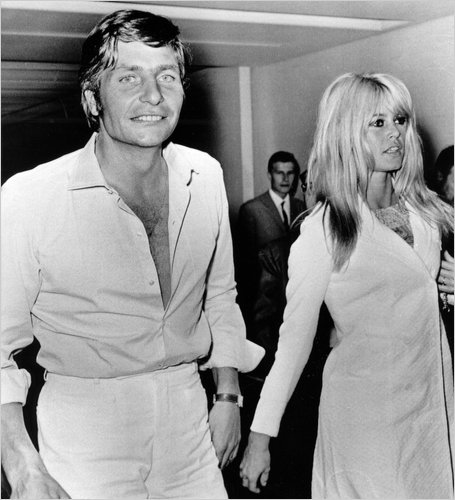 |
Sachs' extensive art collection included works by Jean Fautrier, Andy Warhol, René Magritte, Salvador Dalí, Roy Lichtenstein, Tom Wesselmann, Mel Ramos, and Allen Jones. He also owned important pieces from the Nouveau réalisme school including Yves Klein, Jean Tinguely, Arman, and Martial Raysse. Many of these artists were involved in the 1969 design of the legendary pop-art-apartment in the tower of the Palace Hotel in St. Moritz, which quickly gained the art world's attention. In 1974, he commissioned Warhol with a series of silkscreen portraits of his ex-wife Brigitte Bardot.
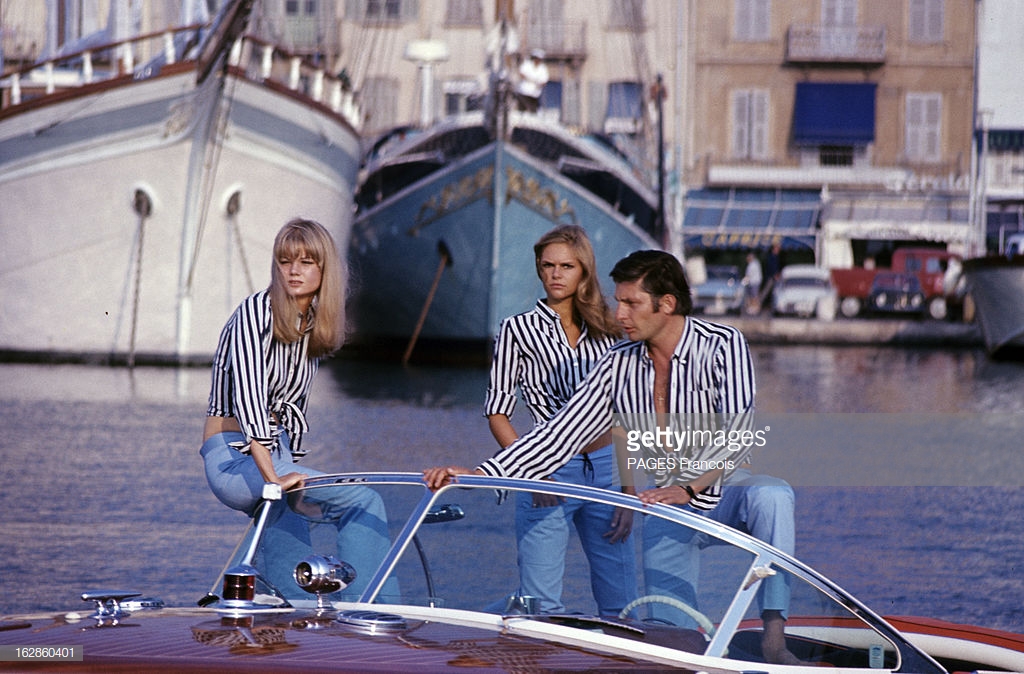 |
 |
Since 1972, Sachs was working professionally as a photographer, in 1973 he caused a stir with the first nude photograph for French Vogue. Sachs was quoted as saying, "In every case, there were significant results, way beyond what is explicable through mere coincidence". Sachs committed suicide on 7 May 2011 by a gunshot wound to the head at his home in Gstaad, Switzerland. The suicide note stated that he acted because of what he defined as "hopeless illness A." (which some have speculated to be Alzheimer's) adding that "The loss of mental control over my life was an undignified condition, which I decided to counter decisively".
Philippe Junot
Philippe Junot got, along with plenty of others, a very young Caroline, the princess of enchanted kingdom of Monaco, the most glamorous place in the world. The most desired conquest on the planet as Caroline, in addition to having a royal class, was beautiful. The marriage with her made the headlines and marked Philippe’s life and career, otherwise mediocre. But Caroline is Caroline and she puts him rightfully among the largest playboys ever. Philippe was for a while the most envied man in the world.

 |
 |
Philippe Junot (born 19 April 1940) is a venture capitalist and property developer with business interests in Paris, and New York City. He is also known as a well-loved, successful man and the first husband of Princess Caroline of Monaco. He is the son of Michel Junot, Deputy Mayor of Paris, former President of Maison de l'Europe, and Lydia Thykjær, the daughter of a Danish industrialist. He is also a descendant of General Jean-Andoche Junot serving Napoleon. Their family name figures on the world famous monument Arc de Triomphe in Paris.

 |
 |
In Monaco, he married civilly on 28 June 1978, and religiously on 29 June, Princess Caroline, eldest daughter of Rainier III, Prince of Monaco, and former Hollywood icon Grace Kelly. The couple were divorced on 9 October 1980. He married Nina Wendelboe-Larsen in October 1987. In 2005 Junot had a daughter, Chloé Junot Wendel, with model Helén Wendel.
 |
 |
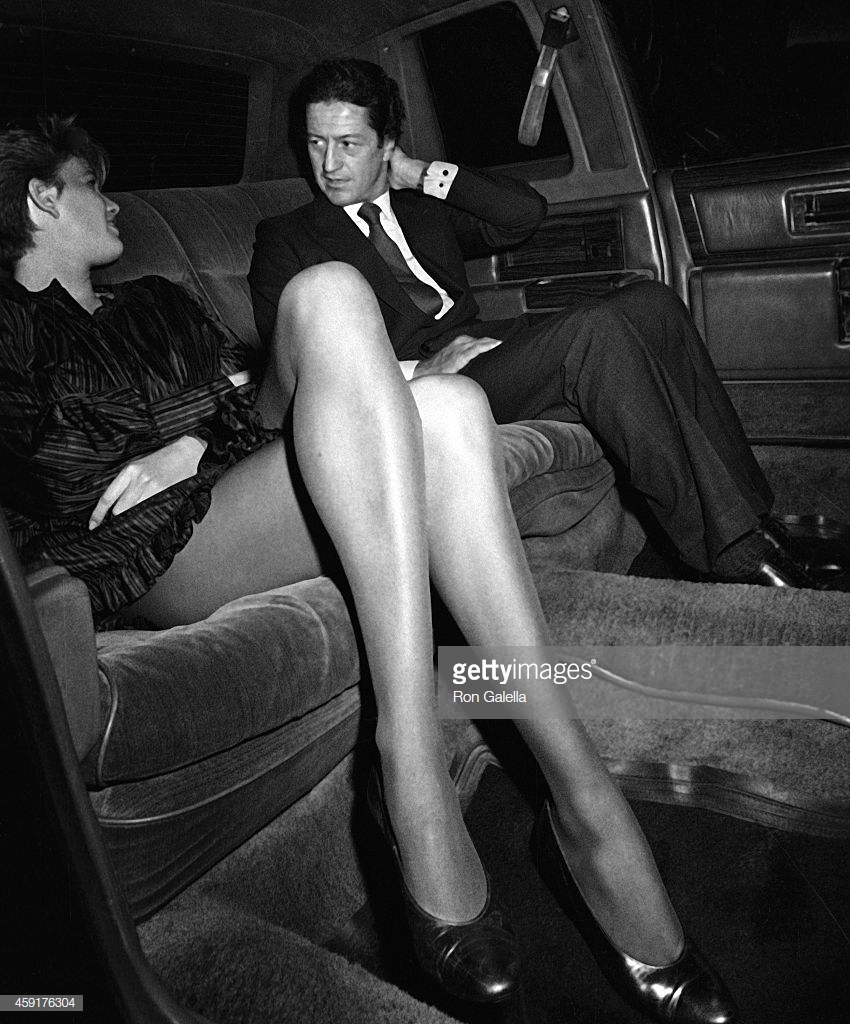
Roger Vadim
He had four of them Roger Vadim, including Ferrari. Maybe the best of all as three women like those not even in paradise. He was not very handsome but for that even better. A triptych ever achieved by anybody ever. Caroline only was left. He won outdistancing all challengers. He won exaggerating. Brigitte Bardot, Catherine Deneuve, Jane Fonda..., Roger Vadim et les femmes.
 |
 |
His Ferrari 250 California was sold for $6 million. Vadim also owned a Ferrari 275 GTB, purchased new and later given to his third wife, American actress Jane Fonda. The Vadim/Fonda Ferrari has never left France since the filmmaker bought it. The car carries a pre-auction estimated value of $3.25 to $4.3 million.

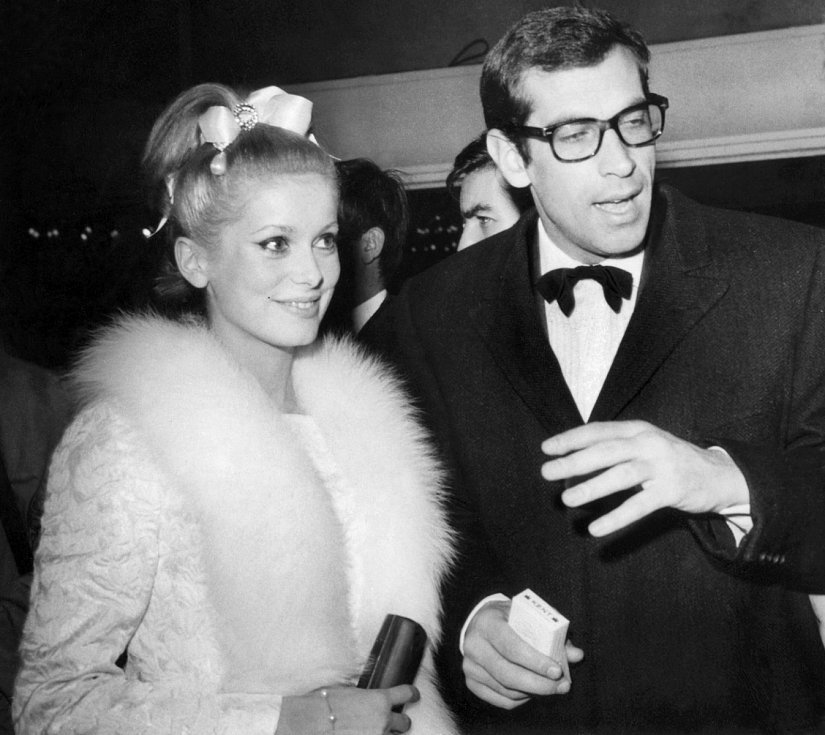 |
 |
Roger Vadim Plemiannikov (26 January 1928 – 11 February 2000) was a French screenwriter, film director and producer, as well as an author, artist and occasional actor. His best-known works are visually lavish films with erotic qualities, such as And God Created Woman (1956), Barbarella (1968), and Pretty Maids All in a Row (1971).
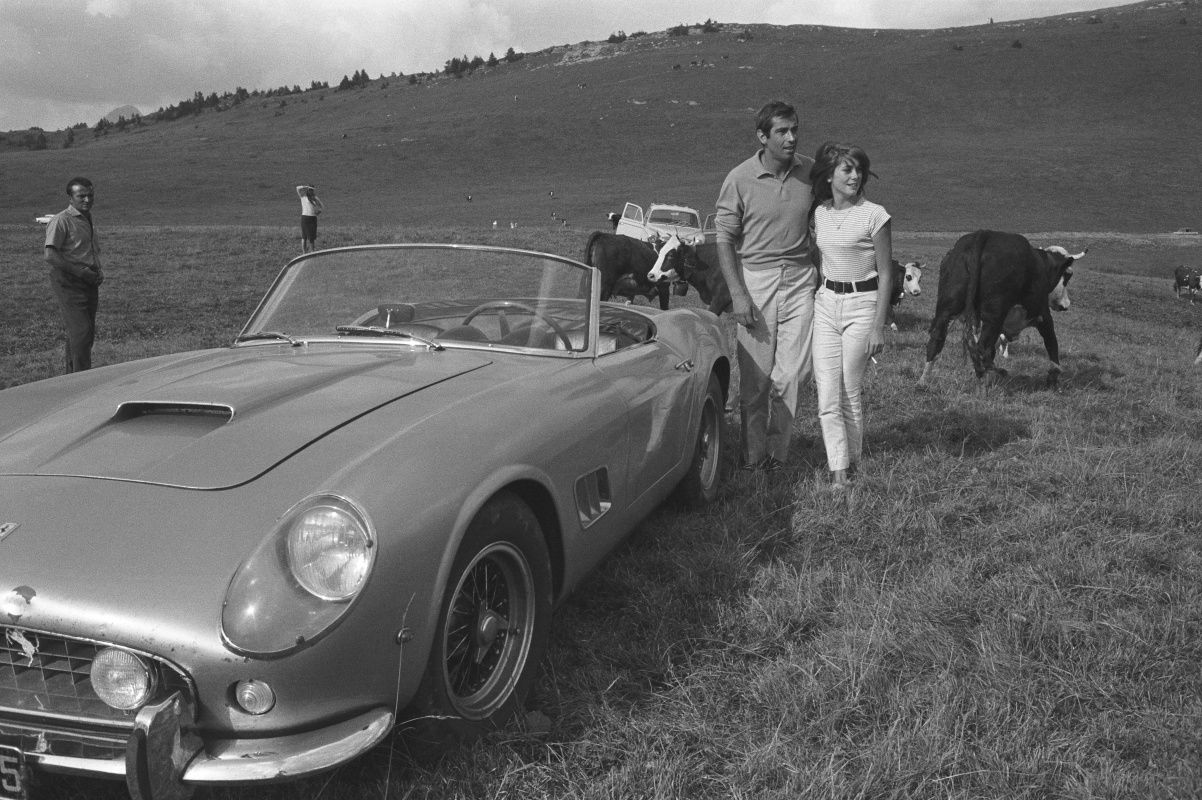 |
 |
Corneliu Vadim Tudor chose his middle name and pseudonym after Roger Vadim. He was born in Paris. His father, Igor Nikolaevich Plemiannikov, a White Russian military officer and pianist, had emigrated from Ukraine and became a naturalized French citizen, and was a vice consul of France to Egypt, stationed in Alexandria. His mother, Marie-Antoinette (née Ardilouze), was a French writer and essayist.
 |
 |
Vadim's first film as director was based on an original story of his, And God Created Woman (1956). Starring Bardot, Curt Jurgens and Christian Marquand, it was not only a major success in France, but around the world, and established Bardot as a world icon. One of Vadims's next film was an adaptation of the book Les liaisons dangereuses (1959), which he wrote and directed. It starred Moreau, Gérard Philipe (in his final film) and Annette Stroyberg, a Danish model who became his second wife. The film became a huge hit in France. They divorced shortly afterwards.
 |
 |
Vadim began a relationship with a young Catherine Deneuve. He said at the time, "when I make a picture about relations between people, something erotic comes through; I can't help it! But sex has been an inspiration, the greatest inspiration, since art exists." One of the film's many stars was rising American actress Jane Fonda who began a romantic relationship with Vadim.
 |
 |
Roger devised a vehicle for Fonda, The Game Is Over (1966), based on a book by Émile Zola. Shot in French and English versions, it was very popular in France, though less so in the US. Dino de Laurentiis wanted Fonda to star in a science fiction sex comedy, Barbarella (1968) and she agreed provided Vadim could direct. During his marriage to Fonda, Vadim would accompany her back to the US periodically while she made movies there. He and Fonda broke up.
 |
 |
In the 1980s Roger based himself in the US. He directed Night Games (1980), where he attempted to make a star of Cindy Pickett, with whom he became romantically involved. His final years were spent working in TV, where he directed Safari (1991) and wrote and directed Amour fou (1993), starring Marie-Christine Barrault who became his final wife. Vadim was famous for his romances/marriages to beautiful actresses.

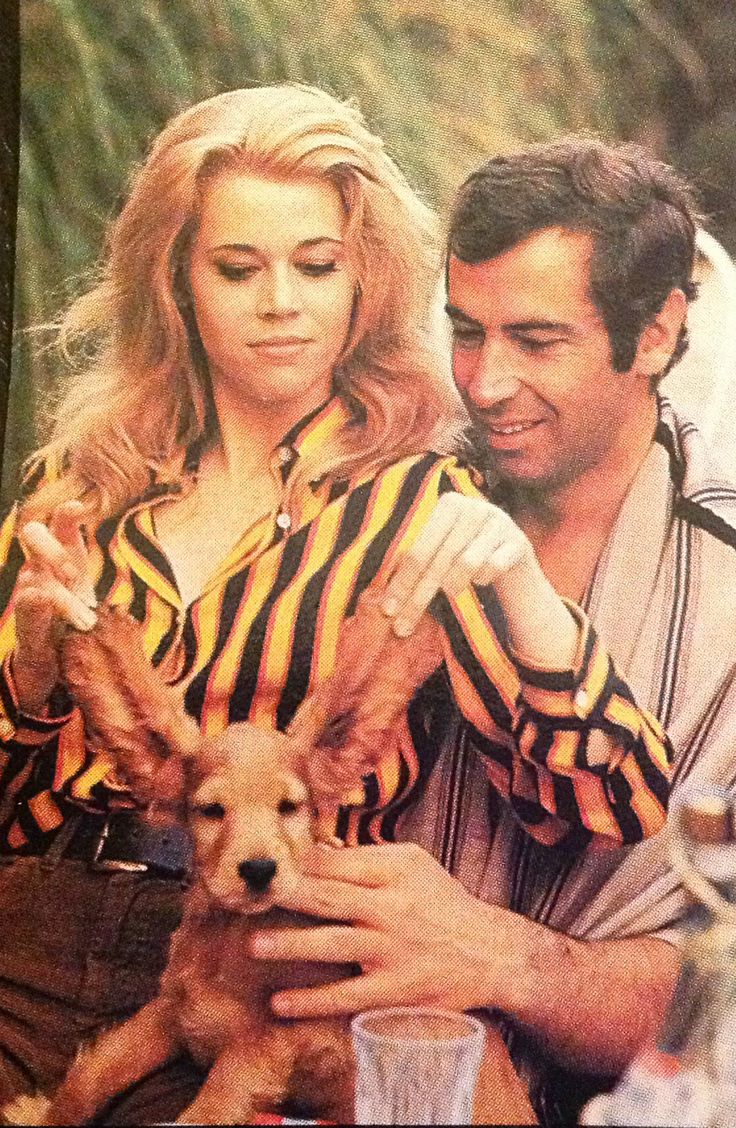 |
 |
In his mid-30s, he lived with the teenaged Catherine Deneuve, by whom he had a child, Christian, prior to his marriage to Fonda. He was also involved with American actress Cindy Pickett. Later, he cohabited with screenwriter Ann Biderman for several years, announcing their engagement in 1984, but the couple never wed. He told a story about how he lost his virginity at age 16 when he spent the summer in Normandy. An older girl took a fancy to him. Outdoors that night, she introduced him to the art of love and what amazed him most was that what Hemingway had written came true: "the earth moved under him." Not until somewhat later did he realize that Allied ships were bombarding the coast in preparation for the D-Day invasion.
 |
 |
He also had two stepsons from his marriage to Schneider (heiress to the Schneider-Creusot steel and armaments firm) as well as adult stepchildren from Barrault's first marriage to Daniel Toscan du Plantier, also a friend of Vadim's, who called him "a happy man. He was someone in whom there was so much satisfaction to the end of his life. The films merely reflected his happiness." Nathalie, his eldest child, told Fonda biographer Patricia Bosworth: "Jane was the love of my father's life."
|
|
 |
In addition to Vadim's theatre and film work, he also wrote several books, including the memoirs "Memoires du Diable", "Le Gout du Bonheur: Souvenirs 1940–1958" and an autobiography, “D'une étoile à l'autre” (from one star to the next) as well as a tell-all about his most famous exes, “Bardot, Deneuve & Fonda: My Life with the Three Most Beautiful Women in the World,” published in 1986.
 |
 |

"My attitude is that if this book makes me a little money it will be a tiny compensation for all the money I helped those actresses make", he explained. Vadim died of cancer at age 72 on 11 February 2000. He was survived by his widow, Marie-Christine Barrault, and his four children (Nathalie, Vanessa, Christian and Vania). Ex-wives Bardot, Fonda, Schneider and Stroyberg were all in attendance at his funeral. He is interred at St. Tropez Cemetery.
Zanza
Maurizio Zanfanti, nicknamed Zanza, wasn’t a lifeguard but was definitely a “birro”. "Il Birro” – in dialect you write “e bir” but it’s pronounced “e bèr” – is a hunter by nature and is equipped with an unfailing instinct trained for generations to hunt down, even from a distance, the only prey that is worthy to be hunted in the Romagna: “la passera” (the pussy).

Prime specimen of Romagna wildlife, il Birro, if you’re lucky enough to be a pretty lady and living in a small provincial town, in addition to smile at you, can’t help but taking you or, stated more correctly, rewarding you with his “Oscià…”, which contains in it the profane and the sacred and all smells and tastes of this fine land full of warmth.
A woman from Romagna knows that there’s no nicer compliment you can receive. A man of Romagna “e’ rumagnòl”, “un Patàca”, is a folklore character; he pops pills at a Riviera’s discotheque only to get old at a "balera di liscio” dancing the mazurka, and he’s characterised by that unmistakable "essssse” (sssss) of his. And there’s nothing to do, a man of Romagna can travel as long as he likes but in the end he always comes back.

In the collective imagination the “birro romagnolo” was the lifeguard: “bagninoo, mi spalma la crema sulla schiena per favore!” (lifeguardd, could you please put cream on my back!), even though we are well past the point where you heard talking to the lifeguard this way. One because nowadays most of the Riviera lifeguards are cool jocks who give you a hard time like any other, two because those few “old-school” lifeguards left have now arthritis in their hands and cannot put cream on anyone, three because today (more than yesterday) a woman to request such a thing would be afraid of being regarded as “someone who likes to kiss and tell” or maybe would be ashamed to let it be known that she does like it.
I remember, a journalist says, the lifeguard at the place where I went to as a child with my parents who, thanks to this trick, had “tombolate” (had) plenty of girls. “Oh, Vanni come la spalmi te la crema non la spalma nessuno!” (Oh, Vanni nobody applies the sunscreen like you do!) the bather on duty chirped, while she was getting her back tagged with suntan lotion by lifeguard’s skillful farming hands.

Farming yes, because in the ’50s, 60s, 70s and again 80s, plenty of lifeguards had arrived to the Riviera from the countryside and after the season they returned to be farmers. Yep! Those lifeguards there knew it all! In fact, even though they weren’t beauties, they “imbarcavano” (towed women) all the time and had helped to create the myth of Birro of the Romagna; lifeguards, rescue, bartenders, waiters, hoteliers and all who worked in the warm season and in tourism.
Today times change … and current lifeguards are worried about fulfiling female client’s needs by providing them with animation services, baby parking, exercises and various gyms, drinks, barbecues … and so on, neglecting maybe that “service” which was the most welcome part to the single female bather or the one who went on holiday without her husband. Because women, especially from thirty years old on, really liked being taken care of and a bit romanced by their lifeguard: it made them feel beautiful and desirable, especially on the beach, where they were maybe afraid not to be, due to their body or age.

The lifeguard, at the same time, was gratified by fidelity of his female bathers who came back every year. Probably out of Romagna the "birro" or “sburone romagnolo" is not well known. The local "stallonismo” died out more than twenty years ago and perhaps more with the disappearance of the last nostalgic specimens of temples now gray.
The "birro", in fact, was nothing other than a product of sex phobic and repressive culture prevalent in Italy in the 50s and 60s. Development and proliferation of this “specie” on our shores depended on the empowerment of Nothern European women (disappointed by their lazy and satisfied compatriots) gathered here for reasons, initially, of tourism only. Then, particularly once word got out among “le Vikinghe” (the female Vikings), the male of Romagna, notably the one raised "a marina" (on marine) among swimming contests, football and racchettoni (tennis on the beach), became much sought after.

Today the life of “vitelloni romagnoli” gets harder every year, and it would’ve been even for Zanza, who had been the undisputed number one of them. Zanza, the most envied man of summers of those years. Didn’t have a Ferrari Maurizio, Mauro as his friends and relatives used to call him, but he won easily like the Reds. And he didn’t brag about himself. Zanza, the king of vitelloni, died an epic death how he lived for most of his life. The most famous playboy in all of Rimini and Italy passed away at 63 while having sex with a 23-year-old girl. He ended up this way, great. He fired his final burst. His death marks the end of an era which is not coming back.
Thirty years ago in Rimini he was just killer and had smokin’ hot women at his feet. He was able to have sex with three different women per day, really crazy. “That was a while ago. Now values are different, references are others,” he was explaining to the newspaper “Il Giorno”.

He had started early, as a “buttadentro” at the mythical “Blow Up” in Rimini: “I was almost a kid, 17, it was in 1972. While in the summer I was artistic director - buttadentro, during the winter I used to go to Northern Europe to sign contracts for the next season. They were much appreciated visits…”. Unfortunately, he concluded bitterly, “they were unique times. The Rimini of today is quite different. We were a slice of heaven, but over the years we have lost a lot, now we play defensive. And foreign women, compared to those years, are very few.”
Nevertheless Swedish women were back to Rimini for a night, on 31 May 2016 for a Scandinavian “amarcord”: at Blow Up again 30 years after pomps of Zanza & Company, on a night dedicated to the revival of Swedish girls (‘Svenska flickor – Rimini 1986’). Maurizio Zanfanti stood up, but dozens of ex of his crew specialized in Scandinavian girls have dusted off 16-ounce gold chains and half-unbottoned (open till the fourth button) hawaiian shirts to try the piing of the flag.

His friend Carmine says about Zanza: “he didn’t consider himself a ladies’ man or a playboy. He has loved his women. He was a very private man. Not even his closest friends knew who was his woman. He said he could remember all his women one by one. He was much more than a bon vivant, he understood people’s problems, he listened to the people. In his mind they all looked alike, he didn’t judge.”
The Rimini that created the character of Zanza, the Rimini in which you grew up together, you made friends, it’s a Rimini which still exists or it has changed? “No, No, it’s a Rimini that is gone, is gone.”

Maurizio was generous, humble, cared by all. He perfectly embodied the character of the Italian conqueror just like lady foreign tourists who came to Italy in the 70s and 80s imagined him. He represented exaggerated and colorful evolution of Fellini “vitelloni”; but characters in the Fellini movie were in the end as melancholic, deluded and dreamers as Zanza was carnal and synonymous with Romagna joy of leaving.
Over the years dozens of legends about Zanza bloomed; such as that of a man from Rimini who goes to Sweden to chase a woman he was in love with and finds on her nightstand a picture of the Italian playboy. “Women go to Rimini for one thing, always because of that …” Maurizio said; but to those who asked him which one was his favorite weapon to sweep female tourists off his feet he revealed: “kindness, you always have to have a thought for everyone.”

An average of more than 5 women per day from 1 June to 31 August, to the point that in Sweden they would even have built a statue in his honor. Furthermore, some murmur that Zanfanti would distribute a picture of him with his signature to his partners, who keep them jealously. Zanza, as he had declared to Corriere di Romagna some time ago, considered himself retired: “how many women I seduced? Given that I’ve worked for 35 years, they could be 6.000. But now what I had to do I did.”
For the king of 'vitelloni' there’s the whole Riviera of Romagna in mourning, but the new started spreading all over Europe. He wasn’t just known, but icon of an era and lifestyle probably unrepeteable. Everybody loved 'Zanza', the Riviera hearttrob, into Romagna and in the rest of Europe, and at the peak of his success he had became also a continental level V.I.P.
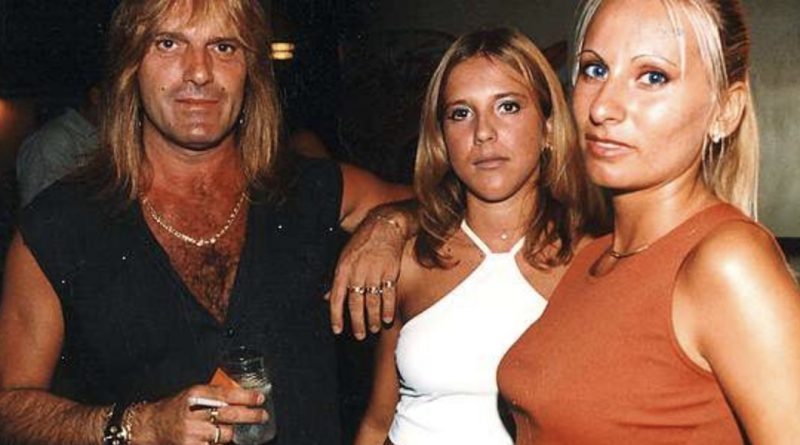
The legend of Maurizio Zanfanti, one of the most hard-working seducers of the whole Romagna Riviera, begins in the 70’s when the Riviera of the Romagna was crawling with tourism and in particular with foreign beauties. Seafront and night clubs are crowded by northern European women. Among these, one more than all: the il Blow Up, with its “buttadentro” “Zanza” Zanfanti. Maurizio had a very kind attitude and the ideal look, a right mix to seduce women. His maximum popularity was in the ‘80s, when he had become a true star and symbol of Romagna carefree summers. Above all Swedish, French, English and German women: Zanza’s summer conquests were a lot. He was able to combine 'macho' seduction with perfect gentleman good manners. According to some, lady tourists chose the riviera of Romagna precisely to meet him. He become so “famous” for his talents that even the Bild, perhaps the most important German newspaper, decided to write an article about him, the “super pappagallo”. He always swore never set foot in a gym, and to have worked out sleeping with the ladies on vacation only.

However, he didn’t just work as 'buttadentro' for the hottest clubs of the riviera. After the success he became a sort of manager and representative of clubs and tour operators of the “riviera romagnola”: during the winter , 'Zanza' traveled a lot to northern European countries, to make deals ahead of the summer period. Plenty of conquests over the years: 'Zanza', in an interview with Il Resto del Carlino, had in fact told, in the most “fruitful” summers, to have been with over 200 women. After he left the job he devoted himself to for so many years, Maurizio Zanfanti became the owner of a bar, il Brigantino. Today Zanza is gone, and those hot summers, made of relaxation, fun and passion, seem much further away. With his disappereance, you can say practically closed a unique era, of an Italy that is gone, and in which the Romagna, even though for a few months a year, became a bit the center of the world. The priest don Raffaele Masi has denied his funeral at church Regina Pacis, where Zanza was confirmed and has taken communion. However, Maurizio passed away surrounded by loved ones. Among them, the Corriere della Sera writes, also four ladies from northern Europe. The best way to remember with love a myth who, however, was above all “a good man, who was fine around people.” And who’s gone as perhaps he always wanted, making love with a girl, who held his hand in his last moments on earth.

The story of Maurizio Zanfanti was plunged on a lot of northern European magazines. That’s why, in addition to friends and family, Italian and foreign television attended the funeral. The last seduction of Maurizio Zanfanti, Italy's most famous holiday lothario. "Zanza", who has died while in flagrante, was the most famous Latin lover of the package holiday boom in Italy, of which the epicentre was his home town Rimini. In his prime, women queued up to be seduced by him and, according to legend, he slept with thousands. He died of a heart attack at around two in the morning in his car, parked in a small peach grove owned by his family, in the company of a Romanian woman, who raised the alarm.
Zanfanti was born on October 20, 1955 into a family of poor peasant farmers who lived near Rimini on the Adriatic coast. Italy was still a largely agricultural country, devastated by the Fascist period and the Second World War but on the brink of the 1960s economic miracle which would see its GDP briefly overtake Britain's. Young Maurizio left school at 16 with no qualifications and in 1972 became a buttadentro (thrower-in, literally) at a notorious discotheque called Blow Up. His job was to search for women on the beach and in bars and entice them with free tickets and smooth talk to go with him to Blow Up. The work paid him a pittance, but gave him carte blanche to accost young women at will and engage them in conversation. His rise to fame as a seaside end-of-the-pier version of Casanova was as rapid as the rise to fame of Rimini as a citadel of hedonism. So effective was he that he quickly earned the nickname Zanza, short for zanzara - the Italian word for mosquito.

In those years, mass tourism transformed the Adriatic coast into one long, endless line of brutally ugly hotels, apartment blocks, bars, restaurants and discotheques, and the sandy shore in front into a forest of beach umbrellas. Federico Fellini was also born in Rimini and his Oscar-winning 1973 masterpiece Amarcord ("I remember" in local dialect) is about a year in the life of this small coastal town before mass tourism stole its soul.
He wrote in a 1976 memoir: "I don't like going back to Rimini." Nevertheless, few Italians cared enough to stop the desecration, since most cared more about the money it brought to their economy. Least of all the young Maurizio. For him, this desecration was not just a means of making a living: it was paradise on earth. Such was his status as a serial seducer of the tourists from northern Europe who flocked to the Adriatic in the 1970s and 1980s in search of sun, sea and sex that he was often front-page news in Germany and Scandinavia.
In 1984 the German tabloid Bild dedicated two pages to him, calling him the "Sex Bomber Der Nation". A pop song he and staff at Blow Up made reached n°2 in the Swedish charts. Short and swarthy, he had dense caveman-style hair which he dyed golden brown. He wore his shirts unbuttoned to the waist or, better still, just a skimpy leather waistcoat, to display to full advantage his chunky gold chains, tanned torso and hairy chest. He invariably wore platform heels and had a fondness for tight leather trousers. But he was blessed with innate charm and it was this - they say - that bowled over the women.

A Norwegian, Mette Homburg, now 50, told the Corriere della Sera after his death that when she met him at Blow Up in 1984 his first words to her were: "ciao, bella. "But they were enough," she explained, "to make me fall in love with him, and I was so in love. He had the air of being a macho man but he was so nice, and so funny." For three years, Mette returned each summer to Rimini just for Zanza, and they remained friends until his death. "I knew he had loads of women, but it didn't matter."
Many other old flames kept in touch down the years and some even organised group trips decades later to see him in Rimini for reunion parties. In a typical three-month summer season, he used to say, his average tally was 200 women, roughly two a day, rising to four a day in the infernal heat of August. He knew how many there were because he recorded each one, with brief details, in notebooks which rapidly filled up and had to be replaced. But he always declined to reveal the grand total, which is reckoned to be 6000.
"They were nearly all foreign women," he said. "The Italians had to make do with my brother." After his death, Walter Lanzetti, who owned the now long gone Blow Up discotheque, told the daily Il Resto del Carlino that he took him on as a buttadentro all those years ago, and then as artistic director, because he knew a bit of Swedish, which no one else did, and he always had a smile on his face. And what drove his passion to seduce women - insisted Mr. Lanzetti, however unlikely it may seem - was an altruistic sense of duty.

"He didn't do it for fame, or to be top of the cucadores [Latin lover] league tables which existed in those days," Lanzetti said, "he just wanted to make women happy. Zanza was a romantic." However, the arrival of AIDS in the 1980s, combined with a growing awareness of feminism, began to curtail his activities. These developments coincided with the decline of the Italian Adriatic as the package holiday destination of choice for northern Europeans. "1988 was a lean summer," Zanza conceded. "Only 120 women."
When in 1993 Bild warned female readers to beware Italian philanderers brandishing forged medical certificates on the beach or in the disco to "prove" that they did not have HIV, Zanza was swift to leap to his own defence. "Me, I keep my certificate signed and countersigned by the doctor in my wallet," he told la Repubblica. "But I've yet to meet a girl who has ever wanted to see it."
In 2015, by now 60, Zanza announced his retirement in il Resto del Carlino, insisting that he had "done more for the promotion of tourism in Rimini than 100 travel agencies". He never married but is thought to have fathered nine children dotted about Scandinavia and Germany. Asked once if he had ever been in love, he replied: "I cannot allow myself to do it. I cannot allow myself to stop ... Work is work."

His family's parish priest refused to allow his funeral in their local church, not because in canon law Maurizio was a peccator manifestus ("notorious sinner"), but because the priest did not want - or so he said - a media scrum in his church. Instead, the funeral took place, regardless of canon law, in the chapel at the cemetery in Rimini in which Zanza was afterwards buried - a stone's throw from Fellini's grave.
Hundreds of people, including the mayor, were present. Many said that Zanfanti deserved if not a street in his name, then at least a medal. Throughout his life as a tombeur de femmes, Zanza lived on the first floor of the family farmhouse above his mother Teresa, who is 80 and still owns a small fishmonger's nearby, his brother Loris and sister Mara, neither of whom is married. They all survive him. Though his mother was "not happy" (as he once put it) with the life he had led, he did his bit each day at the family fish shop and on their farm. After his death, she told the press: "he was a good boy, who always helped me."
Videos
Gigi Rizzi
Gunter Sachs
Philippe Junot
Roger Vadim
Zanza




Comments
Authorize to comment